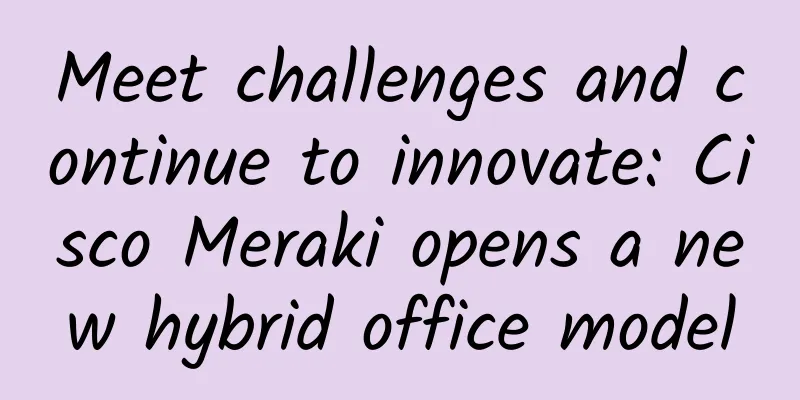Let’s talk about the top ten challenges of 6G

|
This article is reprinted from the WeChat public account "Network Optimization Mercenary", the author is in correspondence. To reprint this article, please contact the WeChat public account "Network Optimization Mercenary". From "Best Efforts" to "Certainty"Due to the nature of the IP protocol, the mobile Internet has always provided a "best effort" service. In the 4G era, since the network mainly connects people, this "best effort" approach can meet people's connection needs. After all, slight network delays and packet loss generally do not affect our experience of online shopping or even watching videos online. However, the connection scope of 5G and 6G networks will expand from people to thousands of industries and everything, which requires the network to be able to provide low-latency, highly reliable deterministic service capabilities, otherwise it may affect the continuous and stable production of enterprises. To this end, 5G can provide end-to-end network service capabilities with SLA commitments and guarantees by introducing technologies such as network slicing and MEC. Facing the future 6G era, as the network penetrates into more industries and more scenarios, the deterministic service capabilities of the network need to be further enhanced. Openness and customizationOn the one hand, it is well known that openness and sharing are the core spirit of the Internet and have promoted its continuous prosperity and development; on the other hand, in comparison, mobile communication networks have always adopted more proprietary technologies and a more closed ecosystem, which has restricted their own development to a certain extent. Entering the 5G era, in order to enable the digital transformation of all industries, mobile networks must promote the integration of CT and IT with a more open attitude to give birth to a wealth of innovative industry applications and promote ecological prosperity. As we can see today, the integration of 5G with cloud computing, edge computing and AI technologies has incubated a large number of industry applications such as AI quality inspection and 5G remote control. Leading operators and suppliers have built an open and flexible MEC edge cloud platform, which can open network capabilities, IT capabilities, tools and application components through APIs, allowing third-party developers and industry partners to quickly customize the development, deployment and launch new applications according to their business needs. Entering the 6G era, this openness and customization capability will continue to evolve, and will provide industry customers with more agile and friendly services through API interfaces to better meet customers' on-demand network configuration and customized applications. Artificial Intelligence NetworkToday, artificial intelligence has been applied to many fields, such as AI image recognition, speech recognition, and automatic translation. On the one hand, as network services continue to develop, more stringent requirements are placed on KPI indicators such as network latency, reliability, and user experience; on the other hand, as networks become more and more complex, it becomes more challenging to maintain and improve network KPIs through traditional manual methods. In order to meet the challenges, current operators and equipment manufacturers are also introducing AI into the network to promote network automation and intelligent transformation. However, to maximize the value of AI engines, they need to be fed with massive amounts of data and enabled by computing resources. For future automated and intelligent networks, AI engines cannot be deployed in just one location or on one device, but must be deployed across the entire network with massive amounts of data and unlimited computing resources, so that intelligence can be injected into the entire network to maximize the potential of AI and the network. Therefore, in the future 5G and 6G era, artificial intelligence networks require AI and networks to empower each other. On the one hand, AI empowers the network to upgrade to automation and intelligence; on the other hand, the network must also empower AI to maximize its value. Specifically, it relies on the low latency and large bandwidth characteristics of 5G/6G networks to allow training data and AI/ML models to flow in all links of the cloud, edge, and pipe ends, and fully release computing power with efficient transportation capacity, thereby achieving higher quality network and AI service capabilities at a lower cost. 100% coverageWe have now entered an era where "one mobile phone can travel around the world", but this data may surprise you - there are still more than 3 billion people in the world who cannot access the Internet. One of the reasons is that it is too expensive to install base stations and lay optical cables in remote areas, or due to geographical restrictions, network construction cannot be implemented at all. In order to achieve 100% global coverage, it has become an industry consensus to build a three-dimensional network integrating air, space and ground in the 6G era. Simply put, base stations are deployed on high-altitude platforms in the stratosphere and low-orbit satellites to allow network signals to "fall from the sky" to supplement ground mobile network coverage, especially to solve network coverage in remote areas such as mountainous areas, sea areas, grasslands, and deserts. Whether this method is low-cost and what the investment returns are remains to be verified, but in the long run, it paves the way for future emerging applications such as autonomous driving, flying taxis, and drone delivery. Terahertz communicationIf the allocation of spectrum resources for mobile communication networks is likened to a journey of pioneering, the "wasteland" to be pioneered in the 5G era is the millimeter wave frequency band, while the "wasteland" to be pioneered in the 6G era is the terahertz frequency band, which is usually referred to as the frequency band range of 100GHz to 10THz. These frequency bands are all uncultivated virgin lands, not only with large areas (large bandwidths), but also unpolluted pure lands. The wireless industry can use them freely and at will without worrying about interference. But the problem is that just as today's millimeter waves still face problems such as weak coverage, high network construction costs, and an immature terminal ecosystem, it is estimated that terahertz in the 6G era will also face similar problems, which require the industry to work hard to solve. Perception and positioningSo far, mobile operators have only used wireless spectrum for communication, but in the 6G era, wireless spectrum can be used not only for communication, but also for sensing and positioning functions, so that communication, environmental perception and location tracking services can be provided through networks and base stations, enabling a large number of emerging applications. For example, wireless signals can be used to identify people's postures and gestures, and the environment in which people and machines are located, to enrich and improve user experience; by sensing ambient temperature, humidity, vibration, air quality, etc., to better ensure the stable operation of various industries and smart cities; by using wireless beams to identify vehicles, pedestrians, roadblocks, etc., to better serve autonomous driving; and by high-precision positioning, new indoor services can be enriched. Maximizing spectrum utilizationWireless spectrum is a scarce resource and an important carrier for promoting continuous innovation in the digital society. Entering the mobile era, countries have created a system for auctioning or allocating authorized spectrum, which has promoted the vigorous development of mobile networks and mobile life. However, past success is not always a reference for the future. Under the traditional method, dedicated frequency bands are allocated to different operators and different network standards, which gradually leads to spectrum fragmentation, spectrum idleness and insufficient utilization, aggravating the contradiction between spectrum supply and demand and reducing spectrum utilization. In this regard, in the 6G era, the wireless industry may re-examine the traditional spectrum allocation mechanism, further evolve dynamic spectrum sharing technology, and achieve more intelligent and dynamic spectrum allocation, control and scheduling by introducing technologies such as AI and blockchain to maximize spectrum utilization. At the same time, the continuous evolution of Massive MIMO and more active and accurate wireless resource scheduling and allocation technologies will continue to improve spectrum efficiency. CybersecurityNetwork security is of utmost importance in supporting the development of the digital economy. In the 5G era, network security is one of the current 5G value propositions, just like low latency, high reliability, and large bandwidth capabilities. Entering the 6G era, technologies such as post-quantum cryptography (PQC) and quantum key distribution (QKD) may be actually applied to the network to ensure super network security. For example, the use of quantum random number generators (QRNG) and quantum key distribution (QKD) enables both parties in communication to generate and share a random, secure key to encrypt and decrypt messages to ensure communication security. Resilience, Redundancy, and Self-HealingAs 5G/6G penetrates into thousands of industries and becomes the foundation and cornerstone for supporting digital production, operation and management, higher and higher requirements are placed on the reliability and stability of the network. Looking to the future, the industry should re-examine the traditional network architecture and strive to build a resilient, redundant and self-healing network to ensure that stable network services can be continuously provided even when a network failure occurs. Green and low carbonPromoting green and low-carbon transformation is a common goal of all countries in the world and an inevitable trend in the development of the ICT industry. Faced with the exponential growth of network data traffic and the continuous increase in network energy consumption, for operators, building a green and low-carbon network is not only the only way to reduce network OPEX costs, but also a responsible act to fulfill social responsibilities. In the future, intelligent networks with perception capabilities and end-to-end AI will help operators achieve the goal of energy conservation and emission reduction. |
<<: How should spaces and plus signs in URLs be encoded?
>>: There are about 180 million users of 5G packages using 4G terminals
Recommend
my country has already achieved commercial use of 5G, with leading technology and scale, but it is difficult to fully popularize it due to three problems
The most frequently heard topic in the past two y...
Huawei OpenLab: An indispensable open cooperation platform for building an IT ecosystem
Normally, the labs we are talking about are labs ...
Talk about the difference between continuous integration, continuous delivery, and continuous deployment
CI needs to have the following: Comprehensive aut...
PacificRack: $8/month Windows VPS-4GB/60G SSD/30M unlimited/Los Angeles
At the end of last month, I just shared the news ...
Common status codes and usage scenarios in HTTP
Hello everyone, I am the front-end developer. Tod...
One article to understand SAN network composition and daily operation and maintenance
[[268180]] 1. What is SAN network? Baidu Encyclop...
Overview of the Latest Data Center Network Architecture Technologies
The network is the most important part of the dat...
An Android hotspot APP actually sold more than 2 million WiFi passwords?
Recently, it was learned that an Android hotspot ...
Huawei takes four major measures to lay out its computing strategy and launches the new AI training cluster Atlas 900
On September 18, 2019, the fourth HUAWEI CONNECT ...
Improving the value of colocation data centers with DCIM
Today, as the popularity of colocation data cente...
5G is in the ascendant, and 6G is coming. Learn about the latest developments and trends
The latest research shows that 5G networks are fa...
Practical analysis of network log correlation on OSSIM platform
This article mainly conducts an in-depth analysis...
VMISS Hong Kong VPS 30% off monthly payment starting from 18 yuan, optional AMD/Intel series
VMISS is a foreign VPS service provider establish...
Let's talk about virtual mobile network security
1. Introduction With the rise of 5G technology, v...
Based on human-machine intelligence, protecting enterprise-level security! Sangfor launches security hosting service
[51CTO.com original article] In recent years, cyb...









